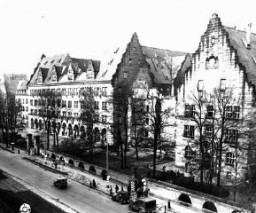You searched for: %EA%B0%95%EC%9B%90%EB%9E%9C%EB%93%9C%20%EC%8A%AC%EB%A1%AF%EB%A8%B8%EC%8B%A0%20St1313.top%20%EC%BD%94%EB%93%9C8899%20SA%20%EC%8A%AC%EB%A1%AF%20%EC%8A%AC%EB%A1%AF%EB%A8%B8%EC%8B%A0%20%EA%B7%B8%EB%A6%BC%20%EC%8A%AC%EB%A1%AF%EC%99%95%20Eob
<< Previous | Displaying results 71-80 of 482 for "%EA%B0%95%EC%9B%90%EB%9E%9C%EB%93%9C%20%EC%8A%AC%EB%A1%AF%EB%A8%B8%EC%8B%A0%20St1313.top%20%EC%BD%94%EB%93%9C8899%20SA%20%EC%8A%AC%EB%A1%AF%20%EC%8A%AC%EB%A1%AF%EB%A8%B8%EC%8B%A0%20%EA%B7%B8%EB%A6%BC%20%EC%8A%AC%EB%A1%AF%EC%99%95%20Eob" | Next >>
-
Rozia Susskind
ID CardRozia was born to a Jewish family in the town of Kolbuszowa. Her family lived outside of town, near her uncles. The Susskinds owned a flour mill and a lumber mill. Their home was one of the few in the area with electricity, which was generated at their mills. Rozia had an older sister, Hanka, and an older brother, Yanek. 1933-39: In the early 1930s, the Susskinds' mills burned down. Hanka moved to Cracow to study in the university and married, and Yanek was working in Kolbuszowa's Jewish bank. The…

-
Jewish Partisans
ArticleSome Jews who managed to escape from ghettos and camps formed their own fighting, or partisan, units during World War II. Learn about life as a partisan.
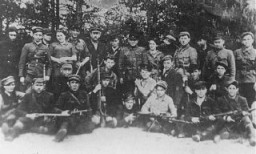
-
Heinrich Himmler
ArticleSS Chief Heinrich Himmler was chief architect of the "Final Solution." Learn more about Himmler, one of the most powerful men after Hitler in Nazi Germany.

-
Lodz - ID Cards/Oral Histories
Media EssayGerman troops occupied Lodz one week after Germany invaded Poland in September 1939. In early 1940, the Germans established a ghetto in the northeast section of the city. More than 20 percent of the ghetto's population died as a direct result of i...
-
Postcard sent to Ruth Segal (front)
DocumentA postcard sent to Ruth Segal (Rys Berkowicz) care of the Jewish Community (JewCom) in Kobe, Japan. Family and friends in German-occupied Warsaw, Poland, sent the postcard on June 20, 1941. It bears stamps both from the Jewish council (Judenrat) in the Warsaw ghetto and from German censors. [From the USHMM special exhibition Flight and Rescue.]
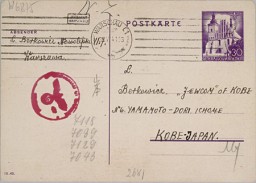
-
Postcard sent to Ruth Segal (back)
DocumentFamily and friends of Ruth Segal (Rys Berkowicz) sent this postcard to her in Kobe, Japan. They sent the postcard from Warsaw, in German-occupied Poland, on June 20, 1941. [From the USHMM special exhibition Flight and Rescue.]
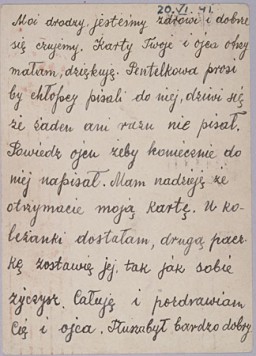
-
Listing of Jews for deportation to Riga, Latvia
DocumentThe SS compiled lists of Jews who were to be deported to ghettos, concentration camps, and killing centers. This document provides the names, birthdates, marital status, and addresses of Jews who were “evacuated” on November 20, 1941 from Germany to the Riga ghetto in German-occupied Latvia.
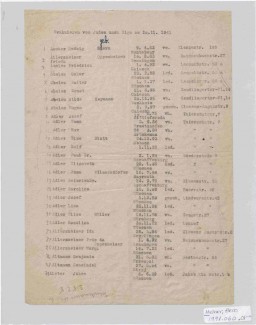
-
Portrait of Hana Ergas
PhotoPortrait of Hana Ergas, wife of Isak Ergas. She lived at Zmayeva 20 in Bitola. This photograph was one of the individual and family portraits of members of the Jewish community of Bitola, Macedonia, used by Bulgarian occupation authorities to register the Jewish population prior to its deportation in March 1943.
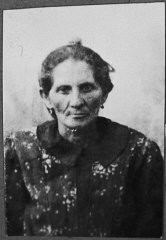
-
View of a criminal wing in the prison at Nuremberg
PhotoView of a criminal wing in the prison at Nuremberg, housing war crimes trials defendants. Baltic guards under the supervision of American authorities patrol the wing and keep constant watch over the prisoners. The upper floors are screened off with heavy chicken wire to discourage suicide attempts. Nuremberg, Germany, between November 20, 1945, and October 1, 1946.
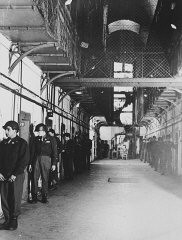
-
View of the Palace of Justice in Nuremberg
PhotoView of the Palace of Justice (left), where the International Military Tribunal trial was held. Nuremberg, Germany, November 17, 1945. The Palace of Justice was selected by the Allied powers as the location for the International Military Tribunal (IMT) because it was the only undamaged facility extensive enough to accommodate a major trial. The site contained 20 courtrooms and a prison capable of holding 1,200 prisoners.
